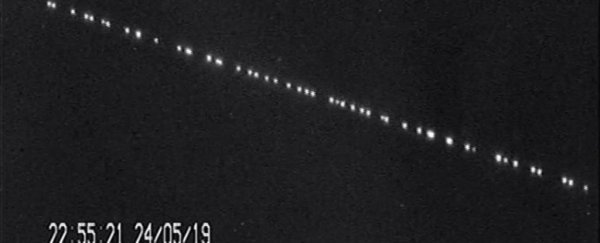With the rapid expansion of commercial space, there is a growing number of satellites in orbit around our planet. Most of these are in low-Earth orbit, which is becoming increasingly crowded.
This has led some to be concerned about a catastrophic rise of space debris, as well as a growing frustration by astronomers due to the number of satellite sky trails.
Currently, the biggest player is the SpaceX Starlink project, which currently has more than 1,700 satellites in low-Earth orbit. They have become notorious for creating bright streaks in astronomical images. But Starlink will soon be followed by other projects, such as OneWeb and Amazon's Project Kuiper.
The goal of all of these projects is to provide easily accessible Internet across the globe, which is a noble goal. But the visibility of these satellites will also pose serious challenges to critical astronomy. While the impact of these satellites on astronomy isn't serious yet, it will be soon, as a recent study shows.
Published in Astrophysical Journal Letters, the study looks at the number of Starlink trails seen in images captured by the Zwicky Transient Facility (ZTF) at Palomar Observatory.
They found that from November 2019 to September 2021 there were more than 5,300 streaks seen in ZFT images. Most of the streaks were seen in twilight images taken near dusk or dawn.
 A Starlink satellite trail seen across the Andromeda Galaxy. (Caltech Optical Observatories/IPAC)
A Starlink satellite trail seen across the Andromeda Galaxy. (Caltech Optical Observatories/IPAC)
In 2019 only half a percent of twilight images had streaks, but they are now seen in about one of every 5 twilight images. This is concerning because twilight images are the most critically important to the search for near-Earth asteroids.
The potential meteor strikes that pose the greatest threat to us are those that are the most difficult to find because they come from a trajectory near the Sun's position in the sky.
The authors point out that this number of streaks isn't high enough to significantly affect the search for potential asteroid collisions. But as the number rises to 10,000 or 15,000, astronomers will start to miss some asteroids. Given current trends, that number will be reached within a year or so.
There are ways to mitigate the effect of these streaks. Painting the satellites and adding reflective panels could reduce their brightness, particularly at infrared wavelengths that are important for near-Earth asteroid detection.
But the study points out that the mitigation strategy currently proposed by Starlink won't be sufficient to avoid an impact on astronomy.
It is clear we will soon need to make some difficult choices about satellite internet. While it could broaden human connection to even the poorest and most remote regions of the world, it could also destroy our ability to view the heavens and more deeply understand the Universe we call home.
If we do not set our priorities and guidelines soon, SpaceX, Amazon, and other mega-companies will make the decision for us.
This article was originally published by Universe Today. Read the original article.
